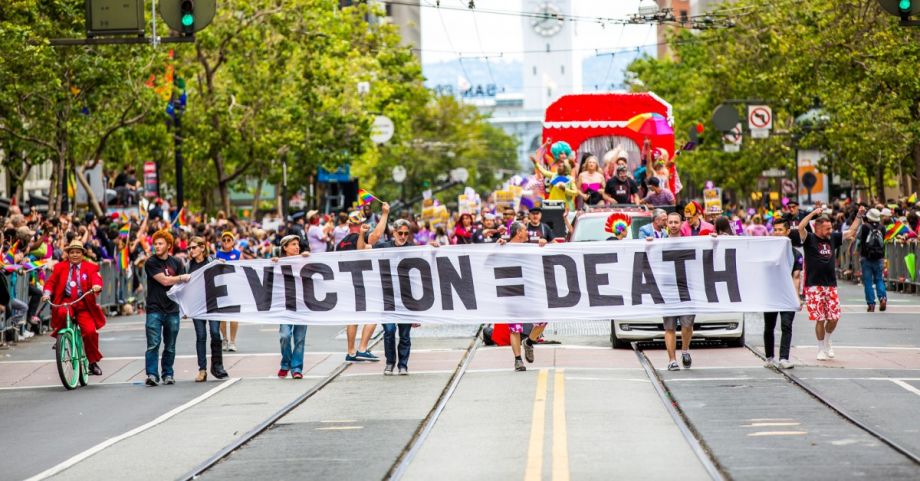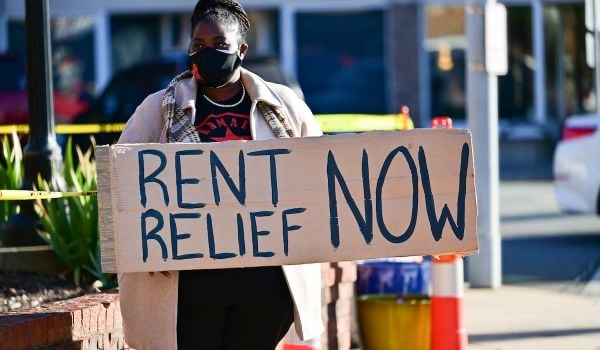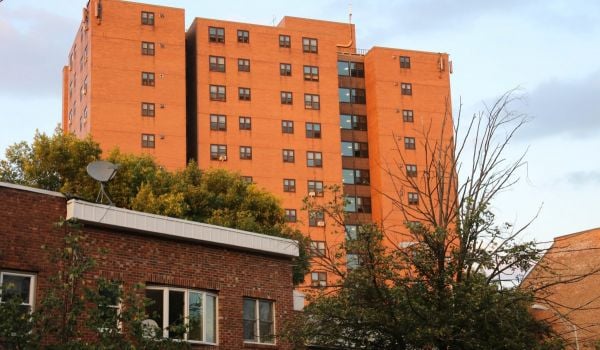Looking at the past year, the story of housing wasn’t necessarily positive. In 2021, housing advocates were forced to spend much of their time fighting with city officials to extend protections that emerged in the early months of the pandemic.
Even as the pandemic claimed more American lives in 2021 than in the year before, many of the emergency measures rolled out to protect people in danger of homelessness or already experiencing homelessness were rolled back. Eviction bans lapsed or were shut down. Relief funds were disbursed too slowly at first and then quickly exhausted. People placed in hotels were forced back to packed homeless shelters. There were also some signs of hope as localities lodged some victories for rent control, stronger eviction protections and experiments with social housing.
Sweeps On Homeless Encampments
In 2020, cities took unprecedented steps to de-densify homeless shelters to protect communities from Covid-19. Officials also briefly looked the other way as encampments emerged across the country, as the CDC advised these outdoor communal spaces were less likely to spread the virus than shelters. But in 2021, sweeps on homeless encampments became more frequent and more normalized across the country in response to NIMBYism and anti-homeless sentiments. The year began with reports of a surge of Covid cases in homeless encampments across Los Angeles, as the state continued to slowly convert hotels to permanent housing through Project Roomkey.
Despite CDC recommendations against clearing outdoor homeless encampments, hundreds of LAPD officers and a SWAT team violently evicted homeless residents from Echo Park Lake in May. Like many homeless encampment sweeps, city officials proclaimed it was a humanitarian move, stating that people experiencing homelessness would be offered Project Roomkey hotel rooms. But the city’s stock of permanent affordable housing is still scant, and the temporary hotel room program has restrictions including regular check-ins that residents are understandably resistant to. Sweeps also continued in San Francisco throughout the year, often with belongings being discarded and in violation of laws that require shelter space to be available.
In many cases, these sweeps occurred in tandem with short-term but high-profile “solutions” that cities had rolled out for homeless populations, facilitated with federal pandemic relief funds. Tiny house villages, which had already spread to Wilmington, North Carolina, Austin, Texas and other cities, began to emerge at scale in California, where villages were built in Oakland, San Jose and San Francisco. The Bay Area also began experimenting with distributing resources to people living in RVs, but it came with increased towing.
In NYC, throughout the summer of 2021, officials moved 8000 unhoused residents from hotels back to crowded dormitory-style shelters in order to facilitate the city’s reopening as vaccines became widely available. As the year ended and Omicron began to surge, many of those residents are again pleading with the city to place them in less crowded hotels, a measure FEMA promised to reimburse.
Eviction Bans Elapsed
The C.D.C.’s national eviction moratorium was shot down first by a U.S. District judge in Cleveland in March. This ban elapsed in July, and a more limited ban wound its way through the courts throughout the summer before the Supreme Court finally weighed in and definitely ended the protections in August. At the time the ban was struck down, states had only distributed 11 percent of the $46.5 billion in emergency rental assistance approved by the federal government.
When the C.D.C’s eviction ban lapsed, some states and cities drew up their own plans and eviction freezes including Boston and New York. Illinois, New Mexico and Colorado also still had statewide eviction bans in September. Connecticut, Massachusetts, Michigan, Minnesota,
Oregon and Virginia had eviction bans tied to applications for federal rental assistance. But nearly all the statewide eviction bans will elapse next year.
According to Princeton’s Eviction Lab, evictions in Somerville, Massachusetts, are banned until April, 2022. And eviction bans in Minnesota and Oregon will elapse in June 2022, the last eviction bans in the country unless they are renewed. These bans only apply to tenants who have applications for emergency rental assistance pending approval.
Some cities increased their eviction protections in other ways, as with a “Right To Counsel” providing lawyers for people in eviction proceedings which passed in Kansas City, Missouri, the 13th such city to pass such an ordinance.
Experiments with Social Housing And More
This year saw more cities experiment with community land trusts and social housing. Many organizers in the U.S. looked to Berlin as a model, as the German city made a deal to buy up 14,750 apartments from private landlords and residents cast their vote for the city to purchase even more.
In San Francisco, a measure to set aside $64 million for social housing was approved by the city’s Board of Supervisors. The money will go to the city’s Small Sites Housing Acquisition program, in which the city lends money to nonprofits to purchase housing in which tenants are at risk of eviction to keep the buildings permanently affordable. Advocates and opponents of the funding agree the program has problems. According to Mission Local, the program’s mixed income housing model requires that all the units rent for an average of 80 percent of the area median income, which has led to vacancies in the more expensive units and therefore less money to subsidize cheaper units. Mayor London Breed, who still has to approve the $64 million spending, has been resistant to reform the program but announced the program would be revamped immediately after the Board of Supervisors vote, offering few specifics.
In Colorado, cities across the state voted separately to fund new housing with taxes on short-term rental housing and sales tax. The measures were a response to the lack of affordable housing for workers in Colorado’s working-class enclaves, and a sign that smaller jurisdictions around the country may increasingly be forced to increase taxes if state and federal governments don’t step up with affordable housing funds.
The Twin Cities saw a series of big victories, as a ballot measure for rent stabilization in Saint Paul was approved by voters, considered one of the strictest in the nation, and in Minneapolis a rent control measure will be hammered out by the city council.
In NYC, the incoming comptroller suggested the city buy 15,000 properties a year to keep permanently affordable, but no legislation exists yet. NYC advocates also suggested buying up properties rather than selling them in the city’s annual tax lien sale, but it nevertheless went ahead as planned.
Climate and housing
2021 may have been the year when the country’s affordable housing crisis and the climate crisis intersected most dramatically. These two crises have of course been intertwined for years, as homes in flood-risk and fire risk zones have increasingly been victim to lax insurance policies, or flipped and sent back into the market for unsuspecting homeowners after a disaster strikes. Thousands of homes across the country have been destroyed already and 20 million people worldwide have already been internally displaced by climate change in the last decade, according to the UN. Real estate brokerage Redfin estimates that just three California counties have $2 trillion worth of rental property at risk from wildfire, and experts anticipate local economies in high-risk areas will be hit hard as people flee inland.
This year, Hurricane Ida demonstrated again that low-income renters are often the first victims of climate catastrophes. In New Orleans, the storm destroyed apartments where tenants had repeatedly asked for repairs to leaks to no avail. This led to more momentum for a “Healthy Homes” ordinance that had died in the city council years prior and which could lead to stricter inspections of leaks, mold or other violations of health and safety standards. The ordinance would also include anti-retaliation measures, so that tenants can not be evicted for requesting repairs.
In NYC, the storm killed 13 Queens residents, 11 of whom were residing in illegally converted basement apartments. Tens of thousands of these units exist in NYC, owing to the city’s lack of affordable housing. The city had briefly funded a pilot project to make these apartments safer, but funding was cut in the early months of the pandemic. While the scope of that pilot, which did not address flash flooding, may not have helped the residents who perished in September, it was a sign of the city’s lack of urgency about New Yorkers in vulnerable and precarious housing.
Cities like Boston also began to shore up their emissions standards for affordable housing, where new city-funded affordable housing projects are required to emit net zero emissions.
New Housing Construction and Beyond
Though it increased sweeps on homeless encampments, no state did more legislatively to increase its stock of affordable housing than California, which may be apt as it includes among the highest rents in the nation. In September, Governor Newsom signed nearly 29 bills meant to spur development of affordable housing. The laws include AB 215, which increases the state’s authority to ensure municipalities are building affordable housing and another law increasing subsidies for nonprofits to build housing more densely. Also in September, Newsom signed SB-9, which will make it easier for homeowners to convert their homes into duplexes or multi-family homes and SB-10 which makes it easier for cities that opt in to the law to build dense housing near public transit. Another law which loosens restrictions for homeowners building new accessory dwelling units on their property, takes effect in January.
Perhaps the biggest housing story this year was the one that did not happen. $170 billion in funding for affordable housing and public housing were in the social spending portion of the president’s Build Back Better Act, which is now unlikely to pass as written. Whether congress passes a smaller version of this bill next year or finds some other way to boost federal funding for housing remains to be seen, but it seems cities will have to forge their own path with limited funds for affordable housing in 2022.
This article is part of Backyard, a newsletter exploring scalable solutions to make housing fairer, more affordable and more environmentally sustainable. Subscribe to our weekly Backyard newsletter.

Roshan Abraham is Next City's housing correspondent and a former Equitable Cities fellow. He is based in Queens. Follow him on Twitter at @roshantone.
















